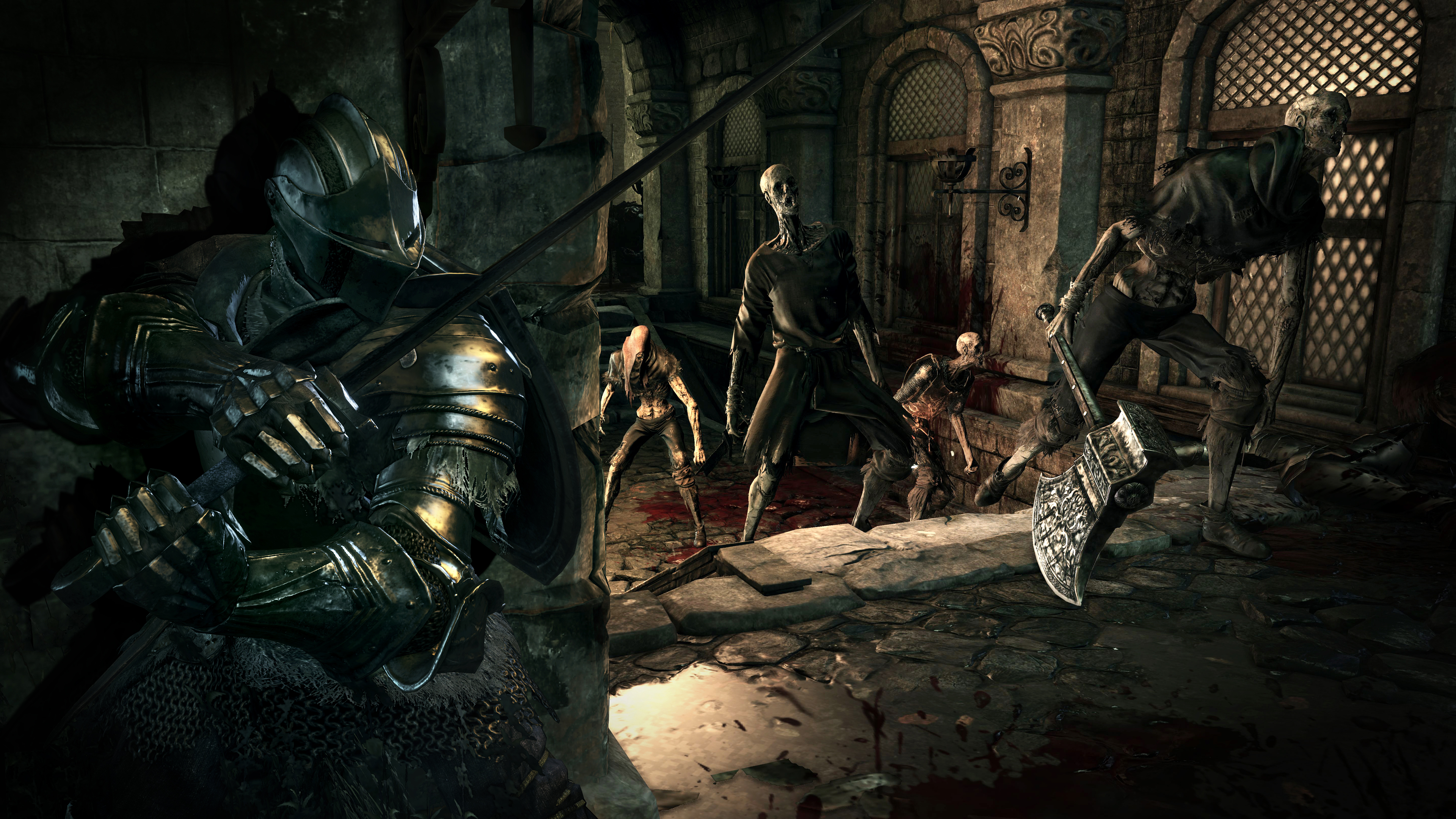You're faster and more dangerous in Dark Souls 3, but so is everything else
Dark Souls 3 has remained enigmatic since its surprise announcement at E3 this year, and not by way of the series' usual systemic arcaneries and lore-based conundrums. Those remain largely unexplained and unexplored, of course, but right now the real question to be asked of Dark Souls 3 is not what it is, but why. After all, between Dark Souls 2's delivery of expansion without evolution, and original director Hidetaka Miyazaki's separate, much more radical development of the series' core values in Bloodborne, even the most loyal of the Chosen Undead must have felt that Dark Souls was logically over. A phenomenal experience left to stand in history, its spirit to live on in differently named descendants rather than further resurrections.

But now Miyazaki is back, with another numbered sequel, which he says will provide the final tweaks to Dark Souls 1.0 before the series changes and reboots. But the question remains: what specifically is Dark Souls 3 for? Mechanically, the series was arguably perfected in its first game. Narratively, it seems to have maxed out delivery of its remit too. Reports of the game, based on all-too brief demos from E3 and Gamescom, have delivered bullet-pointed facts of the its systemic additions (the appearance of more powerful attacks furnished by a new 'ready-stance' chief among them), but what does all of this really mean? What is Dark Souls 3, and what does it truly bring to the Dark Souls experience? To understand that, we need a much longer, deeper session with the game. One, coincidentally, much like the two hours I recently spent exploring it.
I begin to understand the direction Dark Souls 3 is going in as soon as I push the stick forward. I experience a speed and fluidity of movement that all of my experience tells me the mid-weight character I'm using just should not have. It's a revelation compounded when I make my first evasive roll, the movement manifesting not as the expected metallic tumble, but launching with immediate momentum, horizontality taking priority over gravity for the first time in any situation involving moderately hefty armour.

I quickly run the mandatory diagnostic benchmark of my stamina bar's capabilities, and discover that it supplies three standard attacks with just enough left over for the all-important emergency roll. But I also notice that it recharges much more quickly than anticipated. Clearly, this is a game that wants me taking action and making moves. And that becomes even more apparent when I start getting stuck into the area's various zombified fauna.
It’s tough to pinpoint where in the game the demo area is set, but its focus on standard-issue Undead warriors, pikemen and dogs - with the occasional hulking mega-knight thrown in to keep me on my toes - definitely tells me it’s early on. Combat, however, does not play out as I expect. The first goon takes a swing in my direction. I see him move, and prep a preemptive lunge with my Balder Side Sword, to skewer him as he comes in. But I whiff it. This ritual - one that I've practiced a thousand times before - goes wrong, as the wretch comes in harder and faster than predicted, and from longer range, throwing my pre-loaded response completely off-kilter.

This theme continues over the course of the afternoon. Shield blocks don't go up in time. When they do, my opponents prove themselves far more eager and able than before to follow up with unbroken combos, leading my prescribed retorts down the path of messy traded blows at best. Pikemen, it transpires, have made the most of an intensive training course in the art of hit-stun since last we tangled, now shockingly capable of delivering just-too-swift follow-up hits should they manage to poke through my defences. They also seem more hesitant to initiate a battle, far happier to hang back, blocking my path and baiting me to make the first, very risky move.
Even the knights have been powered up, now delivering lengthy tracking combos when blocked or dodged, where before the challenge would have lain in negotiating one or two ferocious incoming blows in order to exploit a lengthy recovery window. It's no longer just a case of ‘block and retaliate’. Dark Souls 3 really does want me to use my newfound manoeuvrability, to defend myself more dynamically, and attack by opening up opportunities much beyond the obvious.
Sign up to the GamesRadar+ Newsletter
Weekly digests, tales from the communities you love, and more

So far, so Bloodborne, then. But it's not as simple as that. This isn't a straightforward case of Miyazaki reskinning his last game with the mediaeval garb of his most notorious. While faster, more kinetic combat is clearly the director's preoccupation these days, the most interesting thing about Dark Souls 3 is the constant tension between the two series, the silent but obvious battle between Bloodborne's influence and Dark Souls' stoic resolve to maintain its own identity.
Shield-up investigation is still the wisest mode of approach for any new encounter. With enemies' rangier aggression still playing off against the precision of Dark Souls' traditional combat, you'll still want to provoke them from (relative) safety, to gauge their abilities before responding. It's just that you can no longer rely on being a mobile fortress by default, the greater range of dynamic attacks and armour-breaking possibilities coming your way forcing quicker retaliations and more improvisational, varied responses.

Dark Souls is still fundamentally about tight, controlled battles in often dangerously claustrophobic spaces, but now you're in less control of the overall pace of each encounter. It's still fundamentally about duels, but now the bigger, previously more methodical opponents will come at you like a freight train. And there are certainly a few nasty, more extravagant surprises to break up your deliberate rhythm along the way - one single, unexpectedly transforming grunt in particular sending me running for safer ground in a furious panic, while frantically jamming the d-pad to crack out the fire-bombs.
Even the much-vaunted new ready-stance attacks, activated by hitting an attack trigger after prepping by holding L2, stand somewhere between a power attack and the high-risk, knife-edge precision of a parry. Differing from weapon to weapon - sometimes unleashing wide, sweeping hits, other times launching enemies sky-high with massive upward swipes - they can certainly devastate, but their effectiveness is built on a precarious foundation of demanding, pre-strike timing, which is amplified by their inability to be charged indefinitely. It's certainly a move that encourages early aggressive action, but it's also one that makes perhaps Dark Souls' most stringent demands so far.
Speaking of demands, the final boss battle of the demo area crystallises all of these new conceits quite marvellously. A towering, blade-wielding monstrosity, all powerful melee strikes and swift, deadly, area-of-effect hits, The Dancer of the Frigid Valley blends the raw power and spatial pressure-game of something like the original Dark Souls' Stray Demon with the flowing, mid-range vulnerabilities of Bloodborne's Vicar Amelia. The fight is a fantastic meeting point for the two series' contrasting key characteristics, requiring both studious use of shielding and a fair degree of opportunistic movement, but always making sure to - tantalisingly - offer slightly more opportunities than my limitations allow. This is Dark Souls, after all. In fact the best, rather well-hidden, response to the beast's deadly, late-fight, double-swipe attack is a perfect representation of Dark Souls 3’s new ethos. Block the first hit, and then immediately roll in to retaliate - praying you have enough stamina left to finish the job - as the Dancer’s near-instant second assault virtually shears the hair from the back of your head.

Knowing what I do now, Dark Souls 3's existence makes sense. It is different, but it is Dark Souls. And it works. Will it be an essential addition? It's too soon to tell. And it would be ridiculous to try to guess at this stage whether Miyazaki is on course to better his original masterpiece. But whatever else Dark Souls 3 achieves, it should certainly deliver a last, meaningful exploration of what Dark Souls can be in its current format, the same recipe seasoned as differently as it can be before it turns into something else entirely. And for serious fans (as if Souls has any other kind), that's more than reason enough to sign up, if only for the closure of knowing that Dark Souls has given us all it can before we move on by Miyazaki's own lead.



